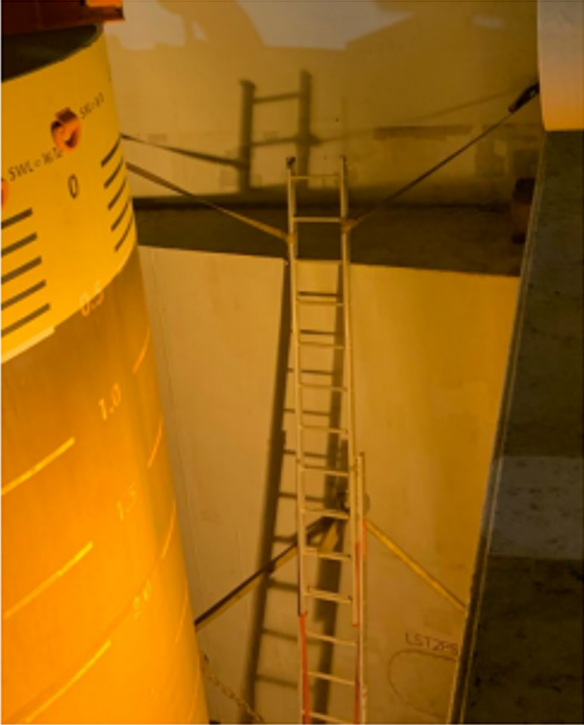LTI – Person fractured pelvis in a fall from a ladder
A crew person suffered a fractured pelvis falling 4-5 metres from a temporary access ladder onboard a cargo vessel. The ladder was installed at a previous equipment mobilisation following realisation that the permanent access / egress hatches to the cargo hold had been blocked. The ladder was secured to a small access platform off the ‘tween deck by means of ratchet straps. The platform edge was 5 metres in height with no handrails or fall prevention and the ladder could only be accessed by stepping over the ratchet straps at the exposed edge.
On previously attempting to access the cargo, the injured person found that the hatches were blocked. He was aware of the ladder, also that it has been successfully used by other persons and believing it to be safe, started to descend. He was alone at this time, it was raining heavily and the equipment and his working attire and PPE were wet. On negotiating the top rungs, he slipped and fell backwards 4 metres to the deck below.
In pain and discomfort he managed to climb up the ladder (the only way out of the hold) to seek assistance. On returning to colleagues, his condition deteriorated, and he was taken to a local hospital where it was confirmed that he had broken his pelvis. The injury required surgery to realign the pelvic bone by means of titanium screws and wires. The injured person needed at least three months to recover.

What went wrong
- Use of the ladder was not risk assessed and no working at height / fall protection mitigations were applied. There was no Management of Change applied when the ladder was installed. A work environment was created which influenced crew to use the ladder, creating a “routine violation”;
- The crew person involved (a Rigging Supervisor) boarded the vessel at an interim mobilisation. There were no ISPS controls, inductions or familiarisations for visitors, who were not accompanied nor made aware of restricted areas on the vessel;
- It was raining heavily and the injured person’s clothing, gloves and footwear (PPE) were wet;
- Stop Work Authority was not exercised – visitors accepted the different HSE standards of the sub-contractor and did not challenge non-compliance. All personnel boarding the vessel at the various mobilisations had the opportunity to challenge the unsafe ladder condition but did not;
- Deck Drawings and review did not identify locations of access/egress hatches leading to them being blocked by mobilised equipment.
What was the cause
Our member drew the following conclusion about root causes:
- Insufficient detail in Cargo Hold Drawing to create a safe load plan
- Design review did not assess safe cargo hold access/egress, stretcher routes and safe movement of personnel;
- Failure to conduct verification activities and ensure compliance.
- Poor risk perception / culture in that personnel did not carry organisational expectations onto a subcontractor worksite;
- Lack of basic operational control.
Lessons and actions
- Thorough engagement with management of sub-contractor to align HSE expectations:
- Ensure thorough review of sub-contractor safety arrangements, documents and compliance;
- Review of the sub-contractor’s load plans;
- Conduct verification activities to ensure a safe working environment and practices prior to starting work (focus on the nine Life Saving Rules and pre-start work checklists);
- Ensure robust worksite supervision and empower personnel to exercise ‘Stop Work Authority’.
- The ladder was removed from the vessel and safe access/egress was implemented.
Members may wish to refer to:
Safety Event
Published: 15 August 2023
Download: IMCA SF 20/23
IMCA Safety Flashes
Submit a Report
IMCA Safety Flashes summarise key safety matters and incidents, allowing lessons to be more easily learnt for the benefit of all. The effectiveness of the IMCA Safety Flash system depends on Members sharing information and so avoiding repeat incidents. Please consider adding [email protected] to your internal distribution list for safety alerts or manually submitting information on incidents you consider may be relevant. All information is anonymised or sanitised, as appropriate.
IMCA’s store terms and conditions (https://www.imca-int.com/legal-notices/terms/) apply to all downloads from IMCA’s website, including this document.
IMCA makes every effort to ensure the accuracy and reliability of the data contained in the documents it publishes, but IMCA shall not be liable for any guidance and/or recommendation and/or statement herein contained. The information contained in this document does not fulfil or replace any individual’s or Member's legal, regulatory or other duties or obligations in respect of their operations. Individuals and Members remain solely responsible for the safe, lawful and proper conduct of their operations.
